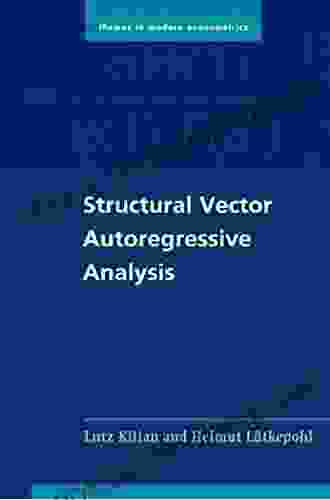Structural Vector Autoregressive Analysis: Themes in Modern Econometrics

4.3 out of 5
| Language | : | English |
| File size | : | 39565 KB |
| Text-to-Speech | : | Enabled |
| Screen Reader | : | Supported |
| Enhanced typesetting | : | Enabled |
| Word Wise | : | Enabled |
| Print length | : | 756 pages |
: Delving into SVAR
Structural Vector Autoregressive (SVAR) analysis has emerged as a pivotal econometric technique, empowering researchers with the ability to uncover causal relationships, forecast economic outcomes, and gain invaluable insights into the intricate dynamics of economic systems. This comprehensive guide delves into the theoretical foundations, estimation methods, and diverse applications of SVAR analysis, providing a thorough understanding of this cutting-edge approach.
By harnessing the power of SVAR, economists can disentangle the complex web of economic variables, isolating the causal effects of various shocks and disturbances. This granular understanding enables researchers to make informed predictions, assess policy interventions, and unravel the underlying mechanisms driving economic fluctuations.
Theoretical Underpinnings: A Foundation for Causal Inference
The theoretical underpinnings of SVAR analysis stem from the seminal work of Christopher Sims. Building upon the concept of Granger causality, SVAR models posit that the current value of an economic variable is influenced not only by its own past values, but also by the past values of other variables in the system. This interconnectedness allows researchers to identify causal relationships between variables, even in the absence of experimental data.
A key assumption in SVAR analysis is the existence of a structural matrix that captures the causal relationships between the variables. This matrix can be estimated using various methods, including ordinary least squares and Bayesian techniques. Once estimated, the structural matrix provides insights into the direction and magnitude of causal effects, enabling researchers to draw meaningful s about the underlying economic mechanisms.
Estimation Methods: Unveiling Causal Relationships
The estimation of SVAR models involves a range of techniques, each with its strengths and limitations. Ordinary least squares (OLS) remains a widely used method due to its simplicity and computational efficiency. OLS estimates the structural matrix by minimizing the sum of squared errors between the actual and predicted values of the variables.
Bayesian estimation methods have gained popularity in recent years, offering greater flexibility and the ability to incorporate prior information. Bayesian techniques account for parameter uncertainty by generating a posterior distribution, providing a more comprehensive understanding of the estimated causal relationships.
Other estimation methods include instrumental variables (IV) and generalized method of moments (GMM),which are particularly useful in addressing endogeneity concerns. By employing appropriate estimation methods, researchers can mitigate biases and obtain reliable estimates of the structural matrix.
Applications: Unlocking Economic Insights
SVAR analysis has found widespread applications in various economic fields, including monetary policy, fiscal policy, and international economics. Central banks use SVAR models to assess the impact of interest rate changes on inflation and output, aiding in monetary policy decisions.
Governments leverage SVAR analysis to evaluate the effectiveness of fiscal stimulus programs, gauging their impact on economic growth and employment. International organizations employ SVAR models to analyze the spillovers of economic shocks across countries, informing policy responses to global economic events.
In addition to these macroeconomic applications, SVAR analysis has also proven valuable in microeconomic research. For instance, labor economists use SVAR models to investigate the causal effects of labor market policies on wages and employment, while financial economists employ SVAR to analyze the relationship between stock market returns and macroeconomic factors.
Advantages and Limitations: A Balanced Perspective
SVAR analysis offers several advantages over other econometric techniques. It allows researchers to identify causal relationships, even in the absence of experimental data, and to make predictions about future economic outcomes. SVAR models can also handle a large number of variables and accommodate complex economic structures.
However, it is important to acknowledge the limitations of SVAR analysis. The accuracy of the results relies heavily on the assumptions made about the structure of the economic system, and misspecifications can lead to biased estimates. Additionally, SVAR models can be computationally intensive, especially when dealing with large datasets.
: A Powerful Tool for Economic Research
Structural Vector Autoregressive analysis has established itself as a powerful tool in the econometrician's toolkit, offering a sophisticated approach to causal inference, forecasting, and economic modeling. By understanding the theoretical foundations, estimation methods, and applications of SVAR analysis, researchers can harness its potential to uncover valuable insights into the intricate workings of economic systems and inform evidence-based policy decisions.
References:
- Sims, Christopher A. (1980). "Macroeconomics and Reality." Econometrica, 48(1),1-48.
- Sims, Christopher A. (1982). "Policy Analysis with Econometric Models." Brookings Papers on Economic Activity, 1982(1),107-152.
- Bernanke, Ben S., and Mark Gertler (1995). "Inside the Black Box: The Credit Channel of Monetary Policy Transmission." Journal of Economic Perspectives, 9(4),27-48.
- Ramey, Valerie A., and Matthew D. Shapiro (2019). "Did the Housing Bust Cause the Great Recession? A Macroeconomic Evaluation." Journal of Monetary Economics, 105, 106-126.
- Stock, James H., and Mark W. Watson (2012). "Dynamic Factor Models." Oxford Handbook of Economic Forecasting, 356-403.
4.3 out of 5
| Language | : | English |
| File size | : | 39565 KB |
| Text-to-Speech | : | Enabled |
| Screen Reader | : | Supported |
| Enhanced typesetting | : | Enabled |
| Word Wise | : | Enabled |
| Print length | : | 756 pages |
Do you want to contribute by writing guest posts on this blog?
Please contact us and send us a resume of previous articles that you have written.
 Book
Book Novel
Novel Page
Page Chapter
Chapter Text
Text Story
Story Genre
Genre Reader
Reader Library
Library Paperback
Paperback E-book
E-book Magazine
Magazine Newspaper
Newspaper Paragraph
Paragraph Sentence
Sentence Bookmark
Bookmark Shelf
Shelf Glossary
Glossary Bibliography
Bibliography Foreword
Foreword Preface
Preface Synopsis
Synopsis Annotation
Annotation Footnote
Footnote Manuscript
Manuscript Scroll
Scroll Codex
Codex Tome
Tome Bestseller
Bestseller Classics
Classics Library card
Library card Narrative
Narrative Biography
Biography Autobiography
Autobiography Memoir
Memoir Reference
Reference Encyclopedia
Encyclopedia Steve Simmons
Steve Simmons Masaaki Imai
Masaaki Imai Paul Goble
Paul Goble Kris Manjapra
Kris Manjapra Vincent Bevins
Vincent Bevins Marjorie Agosin
Marjorie Agosin Peter Oliver
Peter Oliver Kimberly Jones
Kimberly Jones Nia Wyn
Nia Wyn Milton Sanford Mayer
Milton Sanford Mayer N K Jemisin
N K Jemisin Leah Chase
Leah Chase Reginald Dipwipple
Reginald Dipwipple Richard Barrios
Richard Barrios Korpokkur
Korpokkur Matt Wallaert
Matt Wallaert Marge Foley
Marge Foley Michael Ward
Michael Ward Wesley Granberg Michaelson
Wesley Granberg Michaelson Patti Labelle
Patti Labelle
Light bulbAdvertise smarter! Our strategic ad space ensures maximum exposure. Reserve your spot today!

 Wesley ReedThe One Hour Union Jack: Make a Super Simple British Flag in Under One Hour...
Wesley ReedThe One Hour Union Jack: Make a Super Simple British Flag in Under One Hour... Chase MorrisFollow ·4.9k
Chase MorrisFollow ·4.9k Davion PowellFollow ·7.6k
Davion PowellFollow ·7.6k Peter CarterFollow ·13.7k
Peter CarterFollow ·13.7k William FaulknerFollow ·3k
William FaulknerFollow ·3k Justin BellFollow ·2.7k
Justin BellFollow ·2.7k Gavin MitchellFollow ·15.7k
Gavin MitchellFollow ·15.7k Felix CarterFollow ·13.5k
Felix CarterFollow ·13.5k Salman RushdieFollow ·11.8k
Salman RushdieFollow ·11.8k

 Philip Bell
Philip BellPersonal History: From the Last Imperial Dynasty to the...
By Author Name A...

 Gustavo Cox
Gustavo CoxAlexander Csoma de Kőrös: The Father of Tibetology
Alexander...

 Harvey Bell
Harvey BellUnveiling the Titanicat: Dive into the True Stories...
A Literary Voyage into the...

 José Martí
José MartíUnveiling the Festive Flavors of Christmas: A Culinary...
As the crisp winter air fills with the...
4.3 out of 5
| Language | : | English |
| File size | : | 39565 KB |
| Text-to-Speech | : | Enabled |
| Screen Reader | : | Supported |
| Enhanced typesetting | : | Enabled |
| Word Wise | : | Enabled |
| Print length | : | 756 pages |













